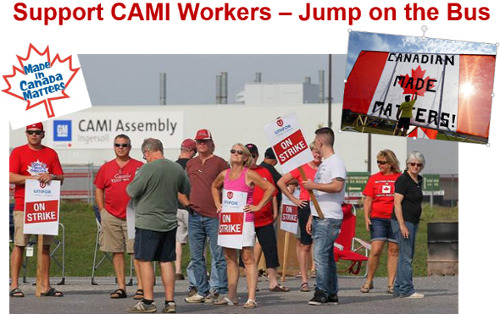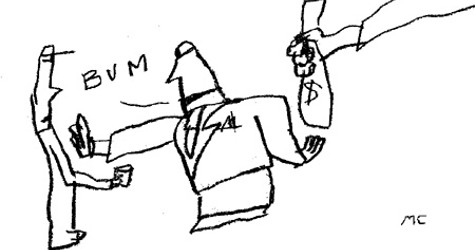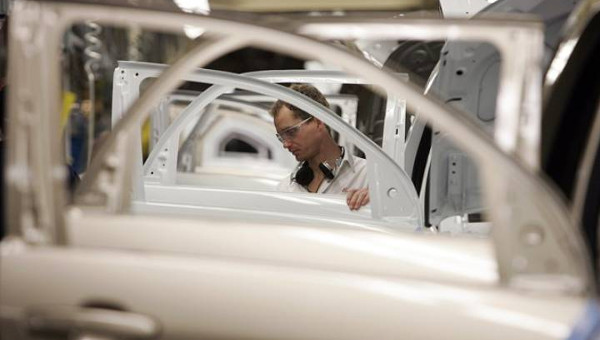MAGNA IS NOT CAMI
Defenders of the agreement between the CAW and Magna’s Frank Stronach argue that the union set a precedent with the 1989 agreement between the union and CAMI, in Ingersoll, Ontario. The following article challenges that claim. It is written by Herman Rosenfeld, a retired national staff representative from the CAW and a member of the team that led a 2 year study of the CAMI workforce, based on a worker survey, shop-floor observations and interviews with managers in 1990-1991.
Also included is a letter to the editor of the Toronto Star, written by Cathy Austin, president of CAW Local 88 at CAMI, and a veteran of that local union since its creation in 1989.
Herman Rosenfeld
In Bob White’s October 30th Op-Ed piece in the Toronto Star, the retired CAW president refers to the current Magna deal as a form of “innovation”, comparing it to the 1980s fight against concessions and the formation of the new Canadian auto union that created a “much more democratic and fundamentally different structure”, and inspired so many workers to challenge employers and fight for the independent political interests of Canadian working people over 2 decades.

The problem is that if you look more closely at the Magna deal, it does nothing but reinforce and legitimate the current Magna labour relations model, limit democracy and provide a structure that is hostile to worker rights. Not only do Magna head Frank Stronach’s workplace structures serve as the cornerstone of the union’s presence inside the workplace, but the union also accepts the denial of the right to strike indefinitely. Today any competitor can argue that a non-union Magna gives it an advantage, since its workers can’t strike. With the new deal, the only thing that would change would be the union’s legitimation of the denial of the strike threat and a company union for Magna to arguably help it compete.
It looks more like the kind of “innovation” so popular these days among the community of pro-management consultants and business analysts, than the kind of innovation that gave hope to so many workers and progressives in Canada and around the world, that there really can be a worker-oriented alternative to neoliberal globalization and worker dependence on employer competitiveness.
Nowhere is that difference more apparent than when comparing Magna with the agreement bargained at the CAMI assembly plant in Ingersoll, Ontario in 1989. The agreement that the CAW negotiated there was, as Bob White says, “radically different from our existing Big Three contracts in many ways”, and certainly was both innovative and controversial. But there the similarity ends. CAMI was also radically different from the current Magna agreement in many ways. Those differences speak to the changes in the union itself.
CAMI – Building a Strong Local Union
CAMI is a joint venture between General Motors and Suzuki, built in the Southwest Ontario town of Ingersoll. It was based on the Japanese production management system originally developed at Toyota, with teams and lean production. Before it was first opened in 1989, the CAW reached an agreement with GM and Suzuki to run a unionization drive without interference from the management. It also bargained a collective agreement before the workforce was hired. The agreement itself included a lot of the verbiage of common commitment to productivity, quality, “kaizen” (continuous improvement) and the entire enterprise of teamwork. The grievance procedure was weak. The wage and benefit package was way behind the Big Three.
It certainly was controversial: there were huge debates at the CAW Council about whether the CAMI agreement was a fundamental betrayal of the union’s principles (because of its weakness, acceptance of “team concept” and agreement before the workers could vote on it), or whether it was a necessary way to organize the workplace, get the foot in the door to build the union and learn how to modify and control the Japanese production model. Many of us at the time were on the negative side on that debate, and were wrong.
CAMI included an elected workplace committee of union representatives, a democratic structure independent of management, to defend workers’ interests. The CAW as a whole maintained a commitment to an independent union presence in the workplace, expressing a different ideology and set of interests than that of the employer. The CAW national representative who serviced the CAMI union was an experienced working class fighter, who helped to mentor the new union reps. (That was only made possible by the existence of the elected body of union representatives, independent of management and beholden only to the members who elected them).
That was reinforced by a CAW Statement on Work Reorganization that asserted:
As we mobilize against regressive taxation, the weakening of unemployment insurance or plant closure legislation, we are reminding our members that the “team” they are on is not the same as their employer, and the ‘adversary’ is not other workers but those who are on the other side of these issues. Similarly, as we take on other collective bargaining issues – like opposing profit-sharing, or demanding indexed pensions or insisting on some movement towards reduced worktime, the message that the needs of working people are quite different from those of management is constantly articulated.
Although the contract accepted the existing Japanese-style production system, the members, backed by the independent workplace structure and supported by the ideology of the larger union (itself, leading important struggles against employers and hostile governments during the late 1980s and 90s) built a strong and militant local union over time. They used collective forms of workplace power to organize resistance to the ongoing speedup. They created space for democratic discussion and debate (such as the local union newsletter, Off the Line). In 1992, (within three years of its founding) Local 88 waged the first ever strike in a Japanese transplant when they made major gains in modifying the lean production system and in the operation of teams. Today CAMI’s wage and benefit package tracks the gains made at the Big Three bargaining table.
As an example of using innovative methods to build a strong, independent union, CAMI is a success.
Magna – Walking Backward
Magna is another story altogether.
The agreement between the CAW and Frank Stronach contains no provisions for the kind of independent, workplace-based union structures that made Local 88 possible. The entire workplace representational structure rests upon the bogus democracy of Stronach’s system, set up to keep unions out.
As was pointed out by numerous critics of the deal: the one union representative in the workplace, called the Employee Advocate (EA), is vetted by a joint labour-management committee and is then subject to approval by the Assistant to the CAW president. Members have no right to vote for or against them for at least 3 years. Other than the EA, there is no in-plant workplace union representation. Instead, a joint “Fairness Committee” has 51% worker representation, elected with conditions that guarantee support for corporate ideology. The agreement stipulates that workers elected to the latter committee can in no way act as union representatives.
This “Framework of Fairness” is based on Stronach’s time-tested system of anti-union structures. Rooted in the human relations practises developed in the 1920s to keep industrial unionism out of mass workplaces, Magna’s paternalistic system attempts to build-in loyalty and dependence on management. It also seeks to individualize worker concerns and issues. All of this is institutionalized in the CAW-Magna framework.
As has also been pointed out, any real effort to create an independent union presence and structure is stymied by the time frame involved in the deal and the commitments embedded in it: it would take about 10 years to organize the various plants in increments of 3 or 4 per year. If the CAW tries to subvert the process at any time, Magna could end the entire project. Besides, the agreement itself commits the union NOT to subvert the process and build an independent union structure.
Needless to say, the collective shop-floor struggles that built Local 88, culminated in the successful 1992 strike and paved the way for the strong union local they are today are not possible at Magna. Workplace struggle would be policed there (according to commitments made in the framework), rather than led by the union.
Another major difference from CAMI is the larger role of the CAW. In the CAMI era, the union was clearly committed to challenging the ideology of partnership and competitiveness, fighting to make gains against employers and defending workplace rights as well as wages and benefits and embarking upon ambitious political projects that questioned the logic of competitiveness and globalization. One can hardly claim that the CAW plays the same role today.
CAMI came on the heels of exciting internal debates over the role of the union inside and outside of the workplace. Magna comes on the heels of years of demoralization, setbacks and a general sense of acceptance, not only in the CAW, but across much of the union movement.
We should not underestimate the challenges that unions like the CAW face today – the power of corporate restructuring, the loss of market share of their major employers to non-union transplants, the lack of any organized political alternatives, and the general despair of the working class. Similarly, it wouldn’t be fair to underestimate the very real concern that leaders of unions like the CAW have in facing these challenges.
But there is a difference between rebuilding the union’s capacity to face those challenges – which requires a more widespread transformation – and simply accepting the employer’s definition of what is possible today.
One has to take the defenders of Magna agreement at their words: when you strip away the disdainful references to critics (armchair critics, academics, etc.), and the claims of “innovation” and “new ideas”, they strongly believe that in this era of weakness and defeat, this is the only way to organize the huge parts giant that Magna is. (One hardly knows what this means for the possibility of ever organizing Toyota or Honda).
This framework does not allow for building a real union – one that represents the independent interests of the members and challenges the power of the employer. Unlike the experience with CAMI, there is no independent structure of workplace representation, no right to use the collective power to withhold labour and no general commitment by the overall union to represent an alternative to the logic and goals of the employer.
There is no short-cut to organizing a real union at Magna or anywhere else. •
To the Toronto Star, October 30, 2007
Dear Editor,
In a recent article “Unions have to innovate to better serve workers” Bob White, former president of the Canadian Auto Workers (CAW), commented about “crafting an agreement in the 1980s at the new CAMI assembly plant in Ingersoll which was radically different
from our existing Big Three contracts in many ways – but which has proven immensely successful to the 2,000 people who work there.”
Having worked at CAMI for the last 18 years I thank the CAW for having the vision to unionize my workplace
every time I walk through the plant gates. As the President of CAW Local 88, representing 2,300 members at CAMI I’d like to highlight some very significant differences between the proposed CAW/Magna Framework for Fairness Agreement.
The first collective agreement at CAMI was negotiated before production started. It offered the barest of guidelines of how ideas such as team concept were actually to be worked out in practice in a unionized environment. The agreement represented a tactical compromise. On the one hand, the contract departed from standard agreements in the auto industry. It committed the union to the principals of the Japanese Production System including team concept, substantial management flexibility and kaizen (continuous improvement). Additionally, the union agreed to an economic package on wages and benefits that fell below the industry norm. However, despite these tactical compromises the first contract contained provisions for important union principals such as union security, recognition of union elected and independent workplace representatives, union committeepersons and a true grievance procedure.
Our local wasted little time in establishing an independent presence in the plant. Over time the union began to demand changes and workers fought back. By contesting CAMI policy and practice, the members increasingly came to see the local as an independent force that championed the cause of workers’ dignity and rights.
There are three fundamental differences between our ‘foot in the door’ collective agreement at CAMI in 1988 and the current Magna deal; first a democratically elected independent union representation directly elected by and accountable to the membership, secondly a grievance procedure, third the right to strike (which we did for 5 long weeks in 1992). The differences between the proposed Magna deal and CAMI are monumental in the lives of workers. At the October 28th membership meeting the members of Local 88 unanimously endorsed a resolution opposed to this flawed agreement. The workers at Magna need and deserve the royal blue colour of the CAW not the yellow of a company union. •
Cathy Austin is the president of CAW Local 88.



